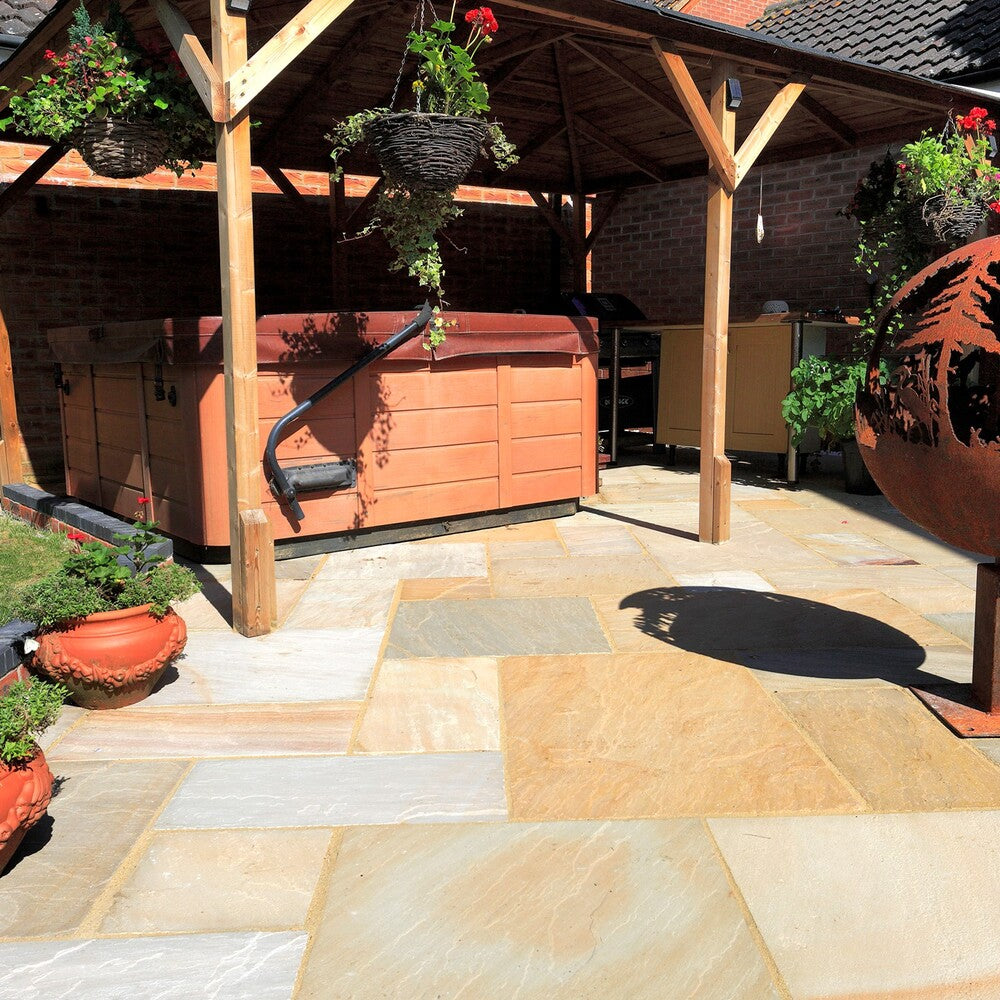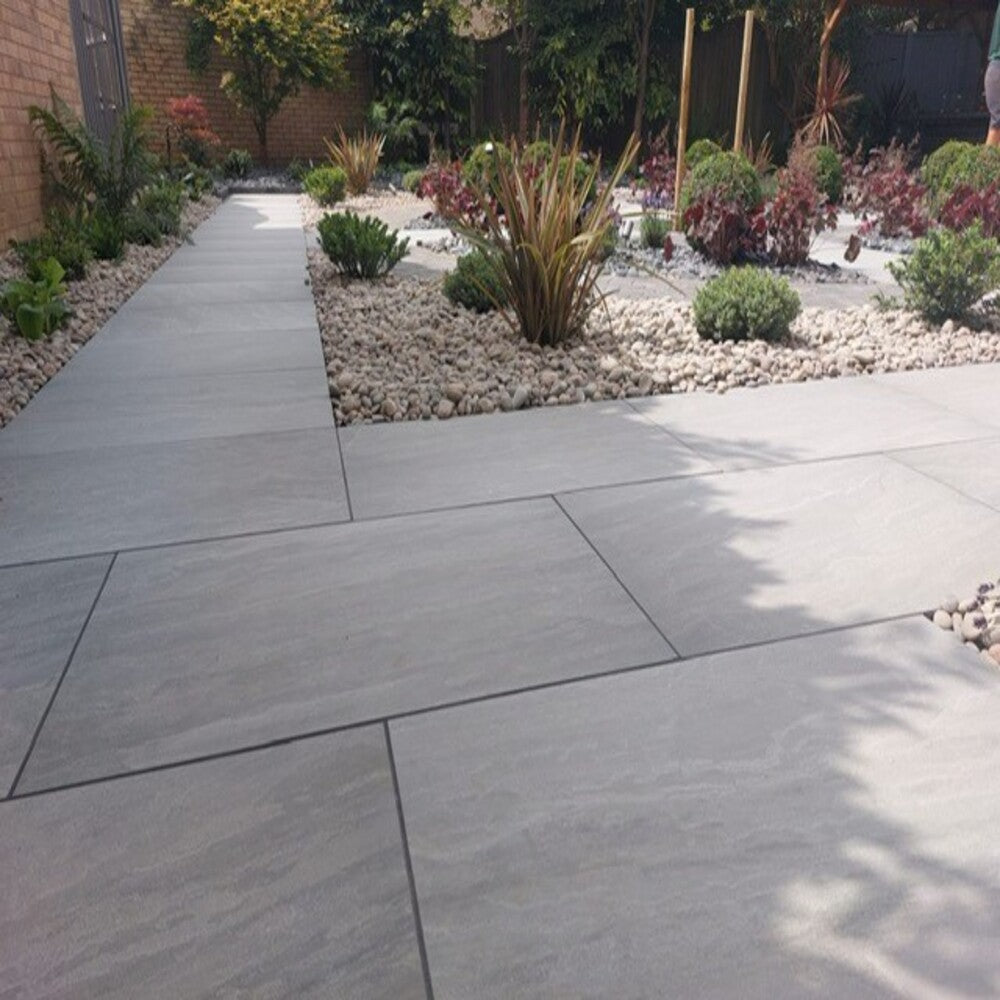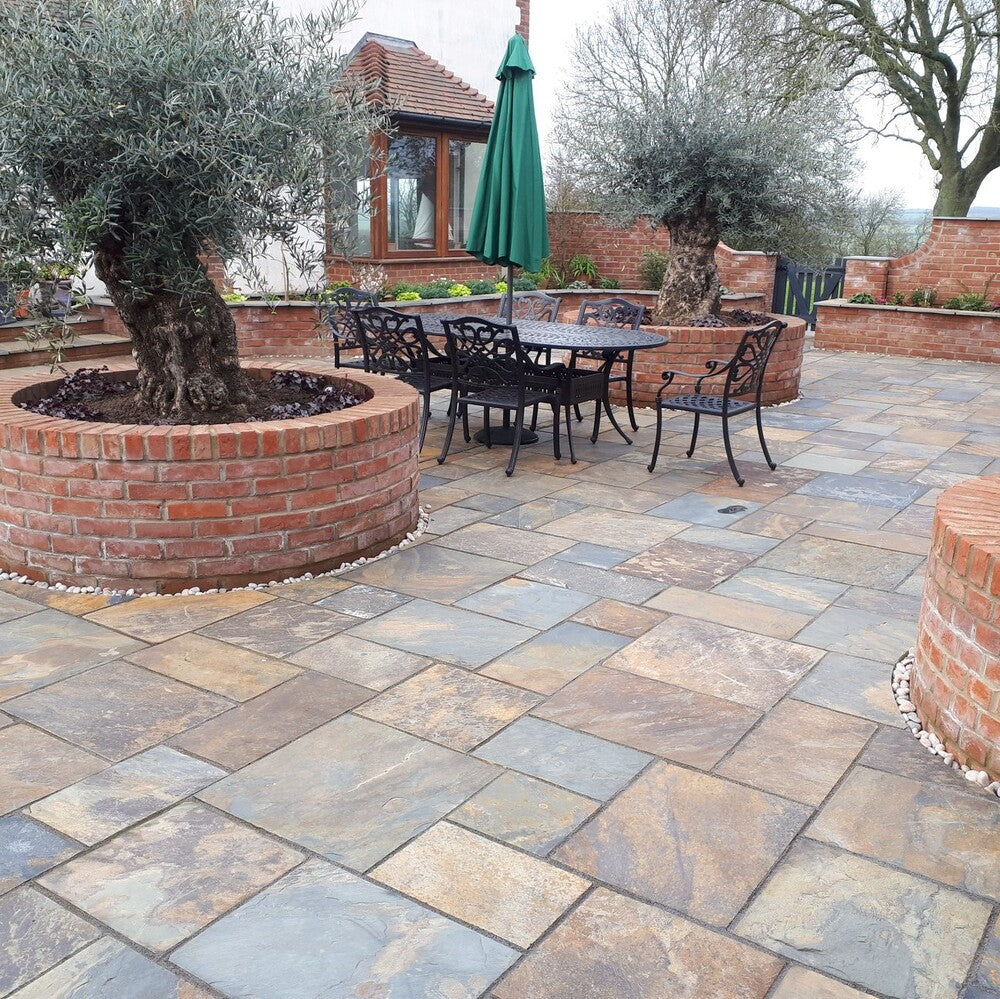When you have found an Indian sandstone patio slab in the colour and texture you love, now you need to think about the paving slab patterns for your patio. It's one of the last decisions you have to make, but it's an important one. There are always new paving ideas to look at and think about, and this is no different. Think about the size and shape that you want your patio area to be and try to envision which patterns might suit. We've also got our virtual brochure to make this task even easier. You can see how your choice of paving would look in any pattern by looking at our virtual brochure here: Virtual Brochure
Different Indian sandstone patterns will create very different visual effects in your garden. The incredible result of rectangle paving slabs laid in a herringbone design is very different to a strong linear slab that leads the eye towards a focal point of the garden feature. The stretcher bond using square slabs also creates a stunning finish too. If you're not sure what these are, we will go over them in a bit more detail as we go through the article.
There are a lot of different options when it comes to Indian sandstone patterns. It’s a good idea to look around and get some inspiration. Remember, slabs come in different sizes and can be laid in different patterns too. For example, our Indian sandstone patio paving kits come with paving slabs in four different sizes, but can also sometimes be purchased in a single size pattern in certain ranges.
Below we talk about just some of the many paving slab patterns that you can choose from. We share an overview of the Indian sandstone pattern and talk about how and why it could work in your outdoor space.
Random Laying Patio Pattern
If you like an informal or a more natural patio design, then a random laying pattern could be ideal for you. It has no definitive geometric or regular pattern but looks really good as an Indian sandstone patio design. Our mixed size "patio packs" are made up to be laid in this pattern. All slabs in these packs are a multiple of 30cm, so fit together in any random pattern you can think of.
There are two ways that you can make the random laying patio pattern work for you. One option is to purchase a selection of Indian sandstone slabs in different sizes. Then you mix the shapes and sizes of the slabs as you lay them. It’s important to make sure you don’t have too many of one shape too close together or left-over slabs at the end. We recommend drawing a patio plan out on paper or setting out your slabs before you lay them. This will help make sure you get the perfect Indian sandstone pattern for your patio.
The other option is to buy a patio project pack with a mix of slabs. This will make it easier to help you achieve that random laying pattern for your patio. You can use clusters of slabs in various sizes in particular arrangements. This is sometimes called a ‘motif’ design. The clusters are then repeated across the patio area. While it is a laying pattern it can be quite hard to spot. However, it offers a really easy way to create a more informal look for your patio.
It can be difficult to come up with small garden ideas, as you don't have much room to work with. But mixed-size patio packs are perfect for this. The random pattern breaks up the area and tricks the eye into making it feel bigger.
Whichever option you choose for your random laying pattern, we highly recommend that you set out the slabs in the intended pattern first. This way you can move stones around and ensure you’re happy with the final effect. Remember, natural stone offers a mixture of natural colours and shades. By laying out the Indian sandstone paving slabs first you can choose where the colours are laid too. This will help show off the natural and beautiful variations in the natural stone.
Stack Bond Laying Patio Pattern
A stack bond laying patio pattern is a simpler laying pattern. It’s also known as the chessboard effect. It looks like a chess board because this Indian sandstone patio is just square slabs in geometric lines. The impact and appeal of this patio design is dependent on the slab size and Indian sandstone paving stones that you choose.
One of the biggest benefits of the stack bond laying pattern for a patio is that it is very versatile. It’s also an easy-to-lay Indian sandstone pattern. It also has very few cuts and minimum wastage too.
The biggest thing to be aware of with the stack bond patio pattern is that the joints and falls need to be exact. Any imperfections, however slight, will be very visible. This is a very unforgiving patio-laying pattern in that respect.
A great way to create regularity with the stack bond paving pattern is to mix slabs of different colours in the same Indian sandstone paving range. Then use the coloured paving slabs intermittently for that chess board look. Another option is to create a contrasting colour as a border around the chess board style pattern in the centre of the paved patio.
Large format slabs work really well for the stack bond paving pattern. Using smooth sawn sandstone that has precise, rectified or sawn edges look really good. They can be laid with narrow joints which will add to the overall finish of this paved patio pattern.
While this is a good porcelain patio pattern, we would not recommend using riven sandstone paving. This will have slightly undulating edges due to the hand-finish of the paving stone. Riven Indian sandstone paving slabs are better suited to informal patterns or random motifs instead.
Stretcher Bond Laying Patio Pattern
If you are looking for one of the simplest paving patterns, then the stretcher bond laying pattern is it. It is also known as a running bond patio pattern, a half bond patio pattern or sometimes an offset paving patio pattern. The different names for this Indian sandstone patio pattern come from the fact that each joint is offset by exactly half the width of each paving slab.
A great thing about the stretched bond patio pattern is that this laying pattern is suitable for any single size of pavers. Once you have the set up right the installation is quick and straightforward. Long and slim linear paving slabs look really stylish for this paving pattern, especially in darker shades of natural stone paving.
If you’re looking to create something a little bit more different then why not consider using two or even four different sizes of paving slab. This will create a satisfying sense of formality with its regular and uniform pattern. However, the variation will add interest and a unique touch to the patio space. This can really help when you are creating a large patio area in your garden.
Herringbone Laying Patio Pattern
The herringbone laying patio pattern is possibly one of the most traditional Indian sandstone patterns out there. You’ll need single-size paving slabs that are rectangular in shape to create this traditional paving stone pattern. It’s a really stylish way of creating a formal period look for your patio.
This patio paving pattern is reminiscent of the patterning you may have seen in parquet flooring in years gone past. It’s really simple and easy to lay too. We recommend 300mm x 100mm pavers or paving blocks for this patio pattern. If you have paths leading to your patio, this paving pattern can be used on the paths too. This works well to bring the path and patio area together in their look and style.
Paving blocks or rectangular paving slabs laid in the herringbone paving pattern will deliver a robust surface for footfall and patio furniture. The herringbone pattern is extremely popular for high traffic areas such as driveways for exactly this reason. The blocks or paving stones interlock next to each other snuggly. This means that they are less likely to slip out of position over time and will look great for years to come.
Patio Pattern Generators
There are lots of patio pattern planners and patio pattern generators available for free online. They work as a great planning tool to create the patio pattern for your garden. The tools allow you to try out different paving patterns and see what they will look like. The tool will then calculate the amount of Indian sandstone paving you’ll need for your patio and your chosen paving pattern.
If your chosen paving slab pattern is using paving slabs of different shapes and sizes it will also work out how many packs of slabs you will need to create the design. This will then help you price up your Indian sandstone patio pattern.
Need help choosing the right Indian sandstone patio pattern for your garden? Call our team now and we can recommend some patterns and help you choose the right one for your outdoor paved area.



